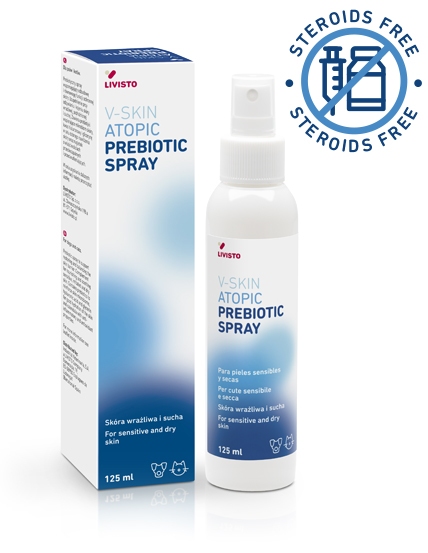ALLERGIC PETS/ATOPIC SKIN
ALLERGIC PETS/ATOPIC SKIN
V-SKIN
ATOPIC
PREBIOTIC SPRAY
Pets with atopic dermatitis have changes in the skin barrier that are fundamental for the development of the pathology, therefore the key is to keep the skin barrier strong and to maintain a healthy skin microbiome. In this way the skin will act as a shield against the entrance of allergens and the adhesion of pathogenic bacteria.
To repair, strengthen and hydrate the skin barrier in dogs and cats with atopic, irritated and dry skin.
It is perfume-free and very gentle on the skin, leaving it hydrated and soft.

Key points:
- Prebiotics to feed good bacteria and keep them strong, so they can keep the skin barrier intact. This barrier will protect the skin against external pathogens and will maintain the pH level of the skin.1, 2
- Hyaluronic acid and glycerin to retain water into the skin and keep it hydrated.3
- Calendula to fight inflammation and oxidation of the skin.4, 5, 6
When to use it:
- Leave-on spray that can be used in areas that are difficult to access.
Can be used daily. Perfect for use after bathing with V-SKIN Clorhex 4% shampoo.
How to use it:
- Spray on to the desired areas.
- Leave-on.
- Does not need to be rinsed off.
- In some cases, it may be advisable to trim the hair to facilitate contact of the product with the skin to be treated.
Watch the product application video!
Vets' opinions
Used the PREBIOTIC SPRAY for a female cat with complaints of redness and dehydrated skin with successful recovery.

When will ATOPIC PREBIOTIC SPRAY be available? I tested it on my own dog and it gives great results!

When applied daily to impetigo lesions on the abdomen in puppies, there was no need for ointments or other antibacterial products.

Moisturised skin for a while, but eliminated itching and skin erythema

References
- Al-Ghazzewi, F. H., & Tester, R. F. (2014). Impact of prebiotics and probiotics on skin health. In Beneficial Microbes (Vol. 5, Issue 2, pp. 99–107). Wageningen Academic Publishers.
https://doi.org/10.3920/BM2013.0040 - Tizard, I. R., & Jones, S. W. (2018). The Microbiota Regulates Immunity and Immunologic Diseases in Dogs and Cats. In Veterinary Clinics of North America – Small Animal Practice (Vol. 48, Issue 2, pp. 307–322). W.B. Saunders.
https://doi.org/10.1016/j.cvsm.2017.10.008 - Juncan, A. M., Moisă, D. G., Santini, A., Morgovan, C., Rus, L. L., Vonica-țincu, A. L., & Loghin, F. (2021). Advantages of hyaluronic acid and its combination with other bioactive ingredients in cosmeceuticals. In Molecules (Vol. 26, Issue 15). MDPI AG.
https://doi.org/10.3390/molecules26154429 - Tresch, M., Mevissen, M., Ayrle, H., Melzig, M., Roosje, P.; Walkenhorst, M. (2019). Medicinal plants as therapeutic options for topical treatment in canine dermatology? A systematic review. BMC Veterinary Researc, (1).
https://doi.org/10.1186/s12917-019-1854-4 - John, R.; Jan, N. (2017). Calendula Officinalis-An Important Medicinal Plant with Potential Biological Properties. Proceedings of the Indian National Science Academy,(0).
https://doi.org/10.16943/ptinsa/2017/49126 - Lima, M. dos R., Lopes, A. P., Martins, C., Brito, G. A. C., Carneiro, V. C; Goes, P. (2017). The effect of Calendula officinalis on oxidative stress and bone loss in experimental periodontitis. Frontiers in Physiology, (JUN).
https://doi.org/10.3389/fphys.2017.00440


 We use cookies on our website to give you the most relevant experience by remembering your preferences and repeat visits. By clicking “Accept”, you consent to the use of ALL the cookies. However you may visit Cookie Settings to provide a controlled consent.
We use cookies on our website to give you the most relevant experience by remembering your preferences and repeat visits. By clicking “Accept”, you consent to the use of ALL the cookies. However you may visit Cookie Settings to provide a controlled consent.